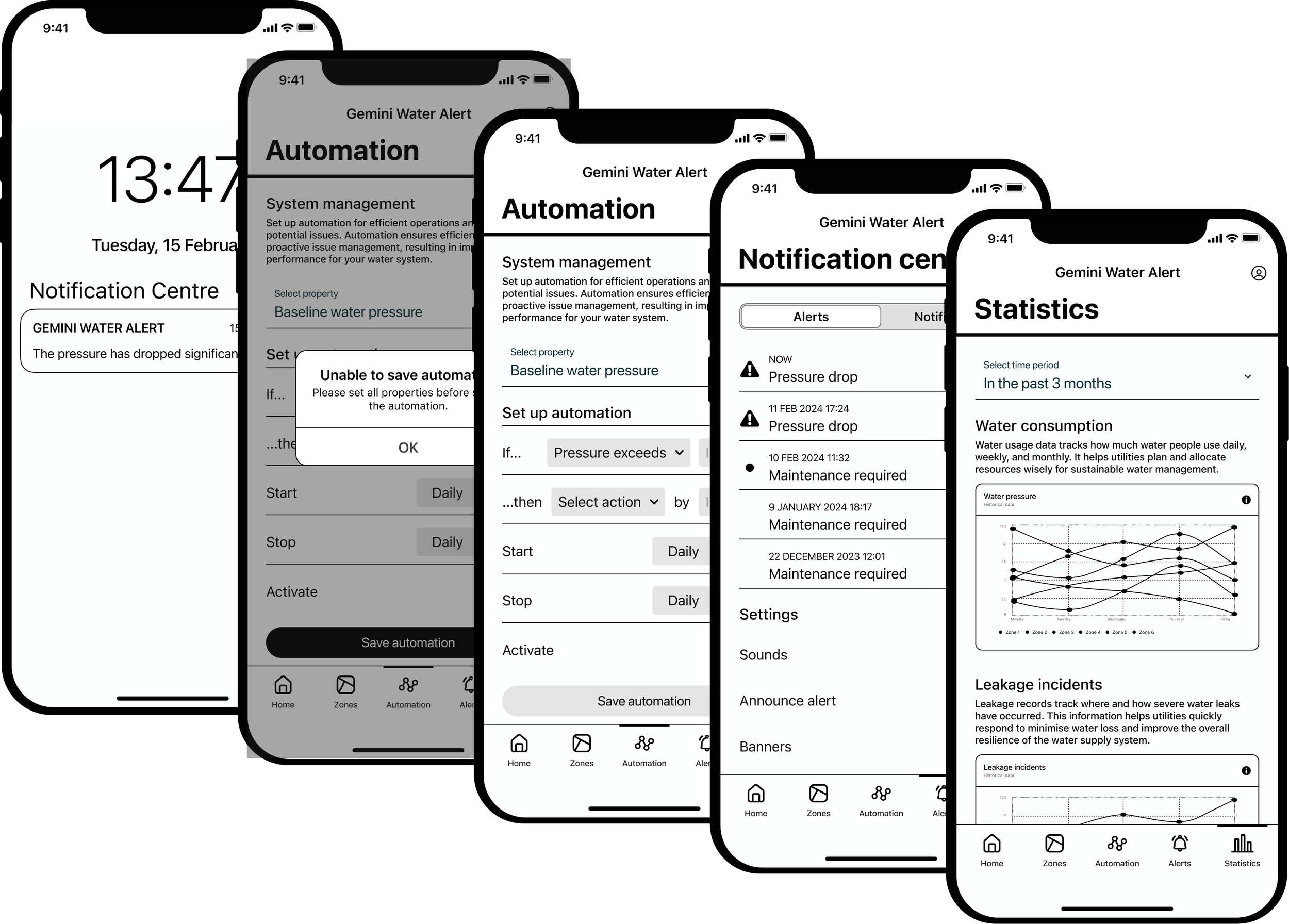How to prevent unnecessary water leakage
QUICK WINS AND LONG-TERM AUTOMATION
Situation: in Norway, the water utility network plays a vital role in residents' daily lives, delivering 200 liters of water per inhabitant each day. However, an estimated 30–40% of this water is lost due to leakages in old and damaged pipes. Traditional solutions involve costly and disruptive pipe replacements, leaving inhabitants without water.
Task: the task at hand is to provide a solution that allows operators in city operating zones to actively adjust water pressure from a centralized operations center. By visualizing real-time data and trends, the operator needs to take timely actions to address pressure drops during peak consumption periods.
Action: the proposed solution involves extending the existing Gemini Water Alert system to include features for adjusting water pressure both manually and automatically. This enhanced functionality integrates machine learning algorithms with data-driven and AI-supported solutions, offering automation options while allowing for manual intervention when necessary. The aim is to empower operators with comprehensive tools to proactively manage and optimize water pressure in the network.
Result: by implementing the extended Gemini Water Alert solution, the operators gain the ability to monitor and control water pressure effectively, reducing water loss from leakages. The combination of enhanced machine learning capabilities and automation features enables efficient decision-making and intervention, ultimately improving the overall performance and sustainability of the water utility network in Norway.
Initiation
Understanding the domain
The company already has its Gemini product family, which provides solutions for flawless water management. For this case, Gemini Water Alert is the one that seems to be the right choice, as the introduction says: “Gemini Water Alert uses machine learning to predict normal water flow within supply zones and generates timely alarms in the event of potential leakages. (...) The solution allows for early water leak detection and prioritization, consequently saving valuable resources.”
What is included in Gemini Water Alert
E-mail and SMS alarms based on user defined thresholds and machine learning.
Prediction of normal water flow within zones. Machine learning takes fluctuation due to weekdays, holidays, and changes in consumption patterns into account.
Administrative tools for managing all sensor types.
An overview enabling prioritization, smart resource management and an increased knowledge of the pipe network.
Conclusion
There are multiple companies and products in this field, therefore the solution should stand out by its robustness, stability and user-friendly management. The suggested solution should be integrated seamlessly to the currently available system, allowing users to use it naturally.
Additional ideas
Easy implementation
Smart pressure sensors: install IoT-enabled pressure sensors in critical points of the water network. These sensors transmit real-time data to the central system, allowing operators to identify and address pressure issues promptly. This solution requires minimal infrastructure changes.
Automated leak detection algorithms: implement machine learning algorithms to analyze pressure data and automatically detect potential leaks. This can be integrated into the existing monitoring system, providing an alert system for quick responses.
Moderate difficulties with implementation
Flow rate monitoring: Install flow rate meters in key areas to monitor water flow continuously. By analyzing variations in flow rates, operators can identify potential leaks and adjust pressure accordingly. This involves some additional hardware but is a moderate level of implementation.
Data analytics platform: Enhance the analytics capabilities of the current system to provide more in-depth insights. Develop algorithms that predict peak consumption times and suggest optimal pressure adjustments based on historical data. This may require upgrades to the existing software infrastructure.
Advanced implementation
Automated pressure adjustment system: develop an automated system that adjusts water pressure dynamically based on real-time demand. This could involve sophisticated algorithms and smart valves that adjust pressure in real-time, minimizing the need for manual intervention.
Predictive maintenance system: implement a predictive maintenance system that uses machine learning to predict when pipes are likely to fail. By proactively replacing deteriorating pipes, the system can prevent leaks and water loss. However, this would require a significant investment in predictive maintenance technology.
Long-term infrastructure update
Pipe replacement strategy: develop a comprehensive plan for gradual replacement of old and faulty pipes. Prioritize high-risk areas based on historical data and gradually replace the pipes to minimize water loss. This is a more extended, capital-intensive solution requiring long-term planning and investment.
Smart water grid: implement a smart water grid with advanced sensors and control mechanisms throughout the entire network. This involves a complete overhaul of the existing infrastructure, making it a long-term and comprehensive solution for efficient water management.
User flow
Login / Create account
Operators log in securely using unique credentials.
Dashboard
Main dashboard displays a real-time overview of the entire water utility network.
Visual representation of operating zones, with color-coded indicators reflecting current water pressure levels.
Live monitoring of current water pressure levels within the selected operating zone.
Visual cues and alerts for immediate attention in case of significant deviations from predicted patterns.
Zone selection
Choose a specific operating zone for detailed insights.
Consumption patterns
Interface displays predicted and historical consumption patterns within the selected zone.
Graphs and charts depict fluctuations due to weekdays, holidays, and changes in consumption patterns.
Pressure adjustments recommendations
System suggests optimal pressure adjustments based on the predicted and historical data.
Recommendations consider current demand, potential leakage risks, and overall network efficiency.
Automated templates with manual override option.
Alerts
Respond to alerts and notifications promptly.
Automated alerts are generated if the system detects abnormal pressure levels or potential issues.
Notifications are sent via email and SMS, providing timely information to operators.
Analytics
Explore historical data and reports for strategic planning.
Access to analytics tools for analyzing the historical performance of the dynamic pressure management feature.
Reports on water conservation achievements, cost savings, and the effectiveness of pressure adjustments over time.
Exit / Log out
Operator exits the system after reviewing and implementing pressure adjustments.
Secure logout to ensure data confidentiality.



